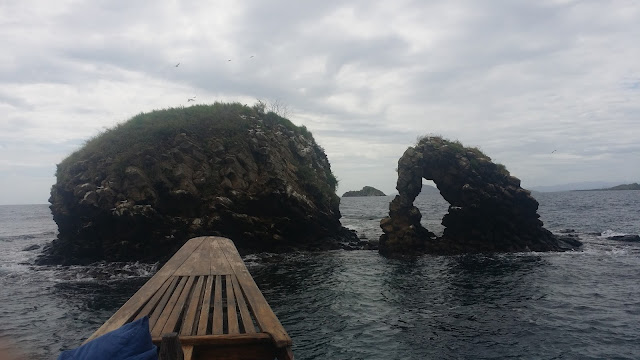The Best Dive Site in the World?
Dive site
of the month: Batu Bolong
This dive site is one of the most famous dive sites in the Komodo National Park – but what is all
the fuss about?!
Well, Batu
Bolong is home to thousands and thousands of fish, we’re talking so many that
you can barely see your buddy just a few metres away.
From the
surface it doesn’t look like much. A bizarre looking rock that sticks out about
5m from the surface of the water. This is where the name comes from – Batu Bolong
translates to ‘Rock Hole’. There’s no doubt about it, this is a weird looking
rock and it’s really just the tip of the iceberg.
This is a
site that is extremely subject to conditions and must only be dived at certain
times. What we aim for is when we can see two distinct current lines coming off
the rock. Maybe I’m getting ahead of myself…
Where is Batu Bolong?
Batu Bolong
sits in the middles of the Lintah strait, – a wide passage of water between
Komodo and Rinca island and in the centre of the Komood National Park. A huge body of water runs through this area and the currents are really impressive.
FYI ‘Lintah’
translates to ‘leech’ – the strait was given this name as the currents leech
boat engines of their fuel! Batu Bolong sits, unsheltered, smack bang in the
middle of it!
When do you dive it?
Given that
this dive site is so exposed to the conditions of the park, we must time the
dive carefully. The current runs, on a rising tide, from the South to the
North. The current hits Batu Bolong and splits out, meaning that the North side
of the pinnacle is sheltered and protected. It can look intimidating from the
surface, as the currents hit the rock it causes them to go a little crazy. The
water is pushed up, and down with impressive strength. On a falling tide the water
moves in the opposite direction, from the North to the South – meaning we dive
the South side. We descend between the two current lines, drop to our maximum depth and zig-zag our way up the reef. It's amazing to see the distinct line of the current and the patterns it creates in the water.
It is diveable all year round and never disappoints!
 |
| The rising tide hitting the rock and splitting around it |
With all these crazy currents, is it safe to
dive?
Of course
it is! As with all the sites in the Komodo National Park it must be treated
with respect and if dived at the wrong time it can get a little tricky. That is
why we like to dive it at the start of a tide change. This is when the currents
are at their weakest. The main thing to avoid is the tide changing on you, this
is what can cause problems. But diving at the start of the tidal change means we
avoid this. Our crew and captains know the waters well and won't dive there if they feel the currents will get too strong.
Around the full and new moon the currents get much stronger, they can wrap back
around causing down currents around the whole rock face. This is something we
want to avoid being in…
What can you see there?
An easier
question to answer would be what can’t you see there! This dive site is fondly
nicknamed ‘fish soup’ and it truly is just that. Schools of thousands and thousands of
anthias make it hard to see the stunning and bountiful corals. These are some of the most wonderful and colourful corals in the whole National Park.
As schools of fusiliers surround you, peek through the amazing show as Giant Trevally start to hunt them.
Large barracudas can be spotted hanging out in the blue. White tip reef sharks
swim through the teeming fish, large moray eels swim across the corals. If
you can bring yourself to focus enough there is some fantastic macro at this
spot as well. Nudibranchs of all shapes and sizes, pygmy seahorses, fascinating
little shrimps and crabs. It can almost be a little overwhelming, the amount of
fish dizzying – but always an amazing experience. Devil rays, dolphins and Mantas
have also been seen whilst diving this incredible rock, and it should considered an absolute must for divers new to Komodo!






Comments
Post a Comment